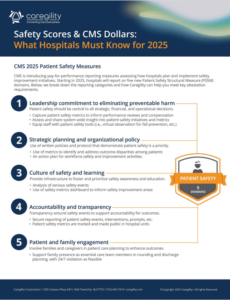
by Susan Kristiniak, MSN, RN
Chief Nursing Officer, Caregility
The Centers for Medicare & Medicaid Services (CMS) are rolling out new Patient Safety Structural Measures (PSSM) as part of the Inpatient Quality Reporting program, and with them comes a pivotal shift in how hospitals will be evaluated for safety performance. These changes bring opportunities, not just for reimbursement, but for elevating safety culture across our organizations.
In our recent webinar, Safety Scores & CMS Dollars: What Hospitals Must Know for 2025, I had the opportunity to walk through what the new reporting requirements mean, how to prepare, and where technology can support your response.
5 Patient Safety Structural Measures
The PSSMs introduce a framework for assessing hospital-wide safety initiatives—not just through outcomes, but through the structures and strategies we put in place to prevent harm before it happens. Here’s a recap of the five domains:
- Leadership Commitment to Eliminating Preventable Harm
C-suite engagement is now required to drive safety strategies, with oversight from your governing board. Safety must be woven into strategic, operational, and financial decision-making. - Strategic Planning and Organizational Policy
Hospitals must outline actionable safety goals, backed by written policies and the use of metrics to address disparities and improve workforce and patient safety. - Culture of Safety and Learning
Fostering psychological safety, conducting root cause analyses, and using safety dashboards to track trends are all part of the expectation to build a responsive and learning-centered culture. - Accountability and Transparency
CMS wants to see mechanisms for secure reporting and transparency around safety events, including how insights are shared across clinical and non-clinical teams. - Patient and Family Engagement
Patients and caregivers are essential partners in safety. Hospitals must support meaningful engagement through activities like bedside rounding and 24/7 visitation when feasible.
Each of these domains has associated attestation requirements that hospitals must fulfill and document, with implications for your hospital’s CMS Star Rating on Medicare Compare and potential Medicare reimbursement.
How Smart Room Solutions Support PSSM Success
Meeting these new standards will take more than policy updates—it will require actionable data and proactive tools to drive performance. That’s where solutions like Caregility Cloud™ come in.
With Caregility, your team gains access to:
- A continuous virtual observation platform enhanced with AI alerts for fall risk, elopement, violence detection, and passive vitals scanning. (Explore iObserver)
- Analytics to track safety interventions, benchmark response times, and evaluate performance by location, patient cohort, etc. (Explore Control Hub)
- Tools to assign and track safety tasks like bed rail checks, patient discharge education sessions, bedside help requests, etc. (Explore iCare Coordinator)
- Virtual engagement solutions to bring families into care planning, improving communication, satisfaction, and outcomes. (Explore iConsult)
These tools don’t just support patient safety, they provide the data infrastructure and documentation needed to meet PSSM reporting requirements with confidence.
Next Steps: Prepare, Share, and Strategize

To support your preparation, we’ve created a helpful PDF resource you can share internally:
📄 Safety Scores & CMS Dollars: What Hospitals Must Know for 2025
This document includes specific attestation requirements you can meet with Caregility solutions. If you’d like to further explore ways we can support your hospital’s safety performance and PSSM reporting goals, we’d love to talk!
📅 Set Up a Discovery Call with our Team
Together, we can help your organization advance a culture of safety and unlock performance-based reimbursement opportunities in 2025 and beyond.









